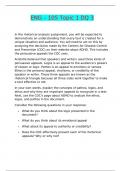Eng 105 topic 3 dq - Study guides, Class notes & Summaries
Looking for the best study guides, study notes and summaries about Eng 105 topic 3 dq? On this page you'll find 59 study documents about Eng 105 topic 3 dq.
Page 3 out of 59 results
Sort by
ENG 105 TOPIC 1 DQ 3 CORRECTLY ANSWERED /LATEST UPDATE VERSION/ GRADED A+

-
ENG 105 Topic 5 DQ 3 ALREADY GRADED
- Other • 2 pages • 2023
-
- $7.99
- + learn more
ENG 105 Topic 5 DQ 3 Provide a sample in-text citation that you plan to use in your evaluation essay you are currently writing. Use one of the head/body/tail combinations from our textbook (Chapter 2). Then create a second citation for the same source, but use a different head/body/tail combination. As the week progresses, comment on your class mates' in-text citations. Do you think they were cited correctly? Why or why not? How do different patterns create different impressions about...
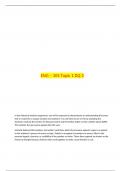
-
ENG – 105 Topic 1 DQ 3 ALREADY GRADED A
- Other • 2 pages • 2023
-
- $7.99
- + learn more
ENG – 105 Topic 1 DQ 3 In the rhetorical analysis assignment, you will be expected to demonstrate an understanding that every text is created for a unique situation and audience. You will need to act on this by analyzing the decisions made by the Centers for Disease Control and Prevention (CDC) on their website about ADHD. This includes the persuasive appeals the CDC uses. Aristotle believed that speakers and writers used three kinds of persuasive appeals. Logos is an appeal to the a...

-
ENG 105 Topic 7 DQ 2
- Other • 2 pages • 2023
-
- $7.99
- + learn more
ENG 105 Topic 7 DQ 2 It is important to distinguish between your perspective and other perspectives regarding your commentary topic. What are some of the other perspectives you see? Summarize them briefly. Next, summarize your own perspective. In what ways does your perspective differ from other perspectives? Why is your perspective different? A few of the other perspectives I am seeing regarding my commentary topic of the abuse/misuse of ADHD medications by college stude...
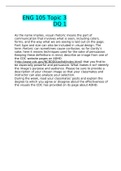
-
ENG 105 Topic 3 DQ 1
- Case • 2 pages • 2022
-
- $7.49
- + learn more
ENG 105 Topic 3 DQ 1 As the name implies, visual rhetoric means the part of communication that involves what is seen, including colors, forms, and the way what we are seeing is laid out on the page. Font type and size can also be included in visual design. The term rhetoric can sometimes cause confusion, so for clarity’s sake; here it means techniques used for the sake of persuasion. Keeping these definitions in mind, describe an image from one of the CDC website pages on ADHD ( During the w...
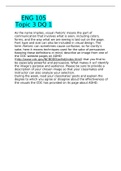
-
ENG 105 Topic 3 DQ 1
- Case • 2 pages • 2022
-
- $7.49
- + learn more
ENG 105 Topic 3 DQ 1 As the name implies, visual rhetoric means the part of communication that involves what is seen, including colors, forms, and the way what we are seeing is laid out on the page. Font type and size can also be included in visual design. The term rhetoric can sometimes cause confusion, so for clarity’s sake; here it means techniques used for the sake of persuasion. Keeping these definitions in mind, describe an image from one of the CDC website pages on ADHD ( During the w...

-
Case ENG 105 Topic 3 DQ 2 Topic 3 DQ 2 Writing an essay can be divided into at least three main parts—the introduction, the body, and the conclusion. Looking further into the essay, the thesis statement can be implicit (implied) or explicit (a line can be
- Case • 1 pages • 2022
-
- $11.89
- + learn more
Case ENG 105 Topic 3 DQ 2 Topic 3 DQ 2 Writing an essay can be divided into at least three main parts—the introduction, the body, and the conclusion. Looking further into the essay, the thesis statement can be implicit (implied) or explicit (a line can be drawn under it).Depending upon the length of the essay, the introduction might be more than one paragraph, but the thesis statement should generally appear at the end of the introduction. Body paragraphs follow, and each has its own unique ...

-
ENG 105 Topic 3 DQ 2
- Exam (elaborations) • 1 pages • 2022
- Available in package deal
-
- $3.49
- + learn more
ENG 105 Topic 3 DQ 2 Writing an essay can be divided into at least three main parts—the introduction, the body, and the conclusion. Looking further into the essay, the thesis statement can be implicit (implied) or explicit (a line can be drawn under it).Depending upon the length of the essay, the introduction might be more than one paragraph, but the thesis statement should generally appear at the end of the introduction. Body paragraphs follow, and each has its own unique topic sentence, the...
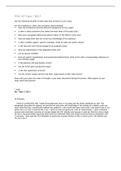
-
ENG 105 Topic 3 DQ 3
- Exam (elaborations) • 1 pages • 2022
- Available in package deal
-
- $3.49
- + learn more
ENG 105 Topic 3 DQ 3 Use the following checklist to help make final revisions on your essay: Are the introduction, body, and conclusion clearly defined? • Does the introduction provide sufficient background for the reader? • Is there a thesis statement that makes the main ideas of the essay clear? • Does every paragraph address the subject matter of the thesis in some way? • Does the essay show that the writer has a knowledge of the audience? • Is there credible support, speci...
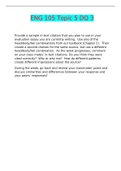
-
ENG 105 Topic 5 DQ 3
- Case • 2 pages • 2022
-
- $7.49
- + learn more
ENG 105 Topic 5 DQ 3 Provide a sample in-text citation that you plan to use in your evaluation essay you are currently writing. Use one of the head/body/tail combinations from our textbook (Chapter 2). Then create a second citation for the same source, but use a different head/body/tail combination. As the week progresses, comment on your class mates' in-text citations. Do you think they were cited correctly? Why or why not? How do different patterns create different impressions about t...

Did you know that on average a seller on Stuvia earns $82 per month selling study resources? Hmm, hint, hint. Discover all about earning on Stuvia

